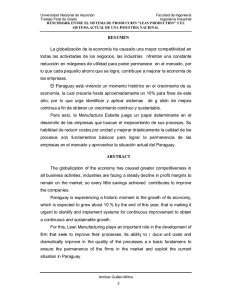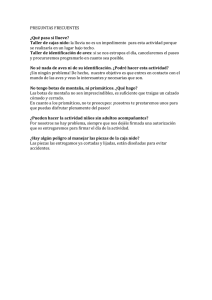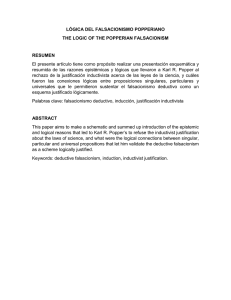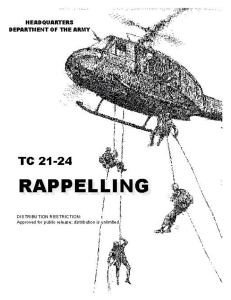redes de seguridad
Anuncio
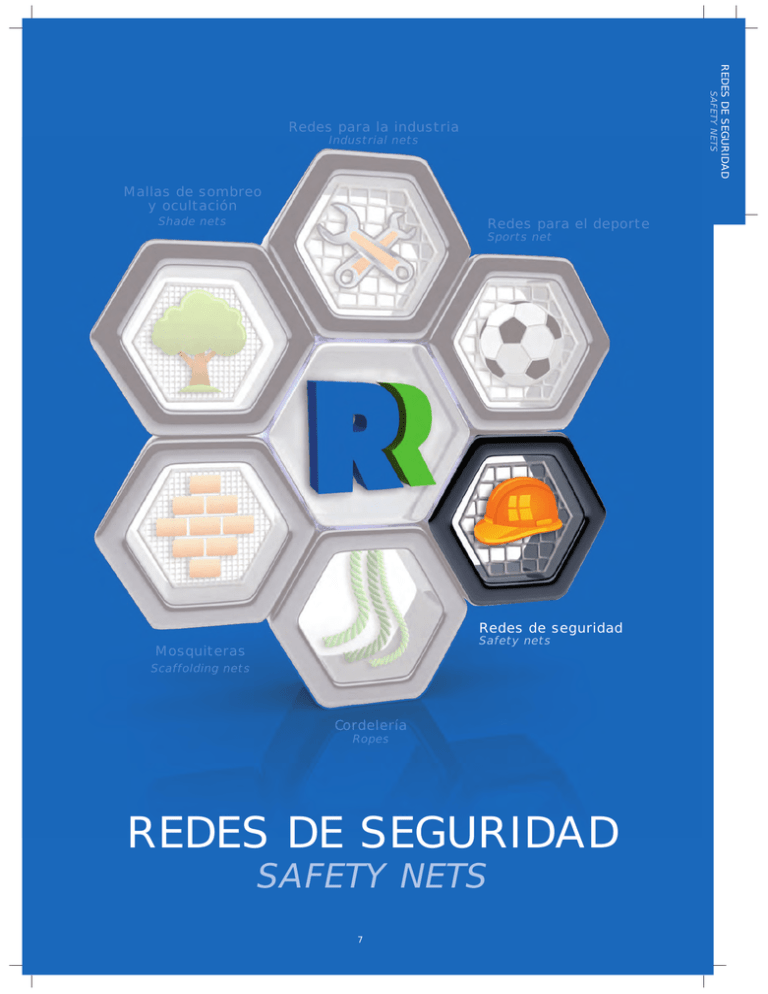
SAFETY NETS Industrial nets Mallas de sombreo y ocultación Shade nets Redes para el deporte Sports net Redes de seguridad Safety nets Mosquiteras Scaffolding nets Cordelería Ropes REDES DE SEGURIDAD SAFETY NETS 7 REDES DE SEGURIDAD Redes para la industria SAFETY NETS REDES DE SEGURIDAD Normativa Regulation La NORMA EUROPEA EN 1263-1: 2002 establece los requisitos que debe reunir los tipos de redes de seguridad y protección según el uso que se hacen de las mismas. The EUROPEAN REGULATION EN 1263-1: 2002 establishes the requirements that the different types of safety and protection nets must have, regarding the use of the nets. Términos y condiciones Terms and definitions MALLA: Serie de cuerdas organizadas en un modelo geométrico (rombos o cuadros) básico formando una red. RED: Conexión de mallas. TAMAÑO DE MALLA: Distancia entre dos nudos o conexiones de una cuerda de malla, medida de centro a centro de dichas conexiones. RED DE SEGURIDAD: Red soportada por una cuerda perimetral u otros elementos de sujeción, o una combinación de ellos, diseñada para recoger personas que caigan desde cierta altura. CUERDA DE MALLA: Cuerda con la cual están fabricadas las mallas de una red. CUERDA PERIMETRAL: Cuerda que pasa a través de cada malla en los bordes de una red y determina las dimensiones de la red de seguridad. CUERDA DE ATADO: Cuerda utilizada para atar la cuerda perimetral a un soporte adecuado. CUERDA DE UNIÓN: Cuerda utilizada para unir varias redes de seguridad. MALLA DE ENSAYO: Malla que se aloja en la red de seguridad para determinar el deterioro debido al envejecimiento y que puede retirarse sin alterar las prestaciones de la red. ESTRUCTURA DE SOPORTE: Estructura a la cual las redes están sujetas y que contribuye a la absorción de la energía cinética en caso de acciones dinámicas. CLASE: Clasificación de las redes respecto a su capacidad de absorción de energía y al tamaño de malla. SISTEMA: Conjunto de componentes de las redes de seguridad que forman un equipo para utilizarlo de acuerdo con el manual de instrucciones. MESH: Series of ropes organized in a basic geometric shape (Diamonds or squares) forming a net. NET: Connection of meshes. MESH SIZE: Distance between two knots or connections of a mesh rope, measured from center to center of those connections. SAFETY NET: Net supported by a border rope or other supporting elements, designed to catch a falling person from heights. MESH ROPE: rope from which the mesh of a net are manufactured. BORDER ROPE: Rope, which passes through each mesh at the perimeter of a net and determines the perimetric dimensions of the safety net. TIE ROPE: Rope used to tie a border rope to a suitable support. COUPLING ROPE: Rope used to join two or more safety nets. TEST MESH: Mesh placed on the safety net to determine any deterioration due to the ageing and it can be removed without affecting the net performance. SUPPORTING STRUCTURE: A structure to which safety nets are secured and contribute to the absorption of the kinetic energy in case of dynamic actions. CLASS: Net classification respective to its absorption capacity of energy and mesh size. SYSTEM: A set of safety net components forming an equipment to be used in accordance with the instruction manual. Clasificación redes Net classification Sistemas de redes Nets systems SISTEMA System V SISTEMA System S Red de seguridad con cuerda perimetral, para utilizar con horcas o pescantes. Red de seguridad horizontal con cuerda perimetral. Safety net with border rope, attached to a gallow type support. Horizontal safety net with border rope. SISTEMA System U CLASE CLASS CLASE CLASS CLASE CLASS SISTEMA A System T C B Red de seguridad para protección lateral, barandillas o andamios. Red de seguridad sujeta a consolas para su utilización horizontal. Safety nets for edge protection attached to brackets. Safety net tied to brackets for horizontal use. 8 Tipo M y G: (Cuerda de atado, sin gaza uso sencillo, con un solo ramal de carga). Resistencia mínima a la tracción 30 kN (S) y 20 kN (V) respectivamente. Type K / P: (Rope Edge). Minimum strength 30 kN tensile strength (S) and 20 kN (V) respectively. Type M and G: (rope tied without bright easy to use, with one branch of load). Minimum strength 30 kN tensile strength (S) and 20 kN (V) respectively. Tipo Z y J: (Cuerda de atado, con gaza uso doble, con dos ramales de carga). Resistencia mínima a la tracción 15 kN (S) y 10 kN (V) respectivamente. Tipo L y F: (Cuerda de atado, con gaza uso sencillo, con un solo ramal de carga). Resistencia mínima a la tracción 30 kN (S) y 20 kN (V) respectivamente. Type L and F: (rope tied with bright easy to use, with one branch of load). Minimum strength 30 kN tensile strength (S) and 20 kN (V) respectively. Type Z and J: (rope tied with bright double occupancy, with two branches of charge). Minimum strength 15 kN tensile strength (S) and 10 kN (V) respectively. Tipo R y H: (Cuerda de atado, con gaza uso doble, con dos ramales de carga). Resistencia mínima a la tracción 15 kN (S) y 10 kN (V) respectivamente. Type R and H: (Rope tied double with loop, with two branches of charge). Minimum strength 15 kN tensile strength (S) and 10 kN (V) respectively. Tipo O: (Cuerda de unión con gaza). Resistencia mínima a la tracción 7’5 kN Sistemas (S,T,U,V). Type O: (rope with loop). Minimum tensile strength 7.5 kN Systems (S, T, U, V). 150 mm Tipo N: (Cuerda de unión con gaza). Resistencia mínima a la tracción 7’5 kN Sistemas (S,T,U,V). Type N: (rope with loop). Minimum tensile strength 7.5 kN Systems (S, T, U, V). * Los extremos de las cuerdas están protegidos para evitar el deshilachado. * The end of the ropes are secured to avoid unraveling. 150 mm Tipos de cuerdas y mallas Rope and mesh types Resistencia mínima a la tracción Minimum traction resistance (kN) Cuerda Rope Denominación Denomination Sin extremos Con gaza Sin gaza Without With bright W / out F x J x V Cuerda de atado Tie Rope a V Cuerda de atado Tie Rope xb V Cuerda de atado Tie Rope b V Cuerda de atado Tie Rope x S Cuerda perimetral Border Rope x a S Cuerda de atado Tie Rope x a S Cuerda de atado Tie Rope x S, T, U, V Cuerda de unión Coupling Rope x S, T, U, V Cuerda de unión Coupling Rope x x M x N 30 x O x V Cuerda perimetral Border Rope xb S Cuerda de atado Tie Rope xb S Cuerda de atado Tie Rope x x x Z x a Si la red se sujeta con una cuerda con un ramal de carga. If the net is attached with a single rope. Notes Notes xa x L P 20 x x H R 15 x G K 7,5 10 Malla Cuadrada Square Mesh Sistema System b Si la red se sujeta con una cuerda con doble ramal de carga. If the net is attached with a double rope. 9 Malla Rombos Diamond Mesh SAFETY NETS Tipo K/P: (Cuerda perimetral). Resistencia mínima a la tracción 30 kN (S) y 20 kN (V) respectivamente. REDES DE SEGURIDAD Tipos de cuerdas Types of rope SAFETY NETS REDES DE SEGURIDAD La gama más completa de redes de seguridad The most complete range of safety nets Toda la seguridad que necesita su obra o proyecto. Le solucionamos cualquier requisito específico que se le plantee, incluso le fabricamos la red a medida. All the security you need for your work of project We will solve any specific needs that will arise, we also manufacture net by any sizes. SISTEMA System T PARAVIENTOS Windscreen 10 System V BAJO FORJADO Forged under SISTEMA System U SISTEMA S System SEÑALIZACIÓN Signal 11 SAFETY NETS SISTEMA REDES DE SEGURIDAD REDES, CORDELERÍA Y MALLAS SAFETY NETS REDES DE SEGURIDAD Formación Training En Rombull Ronets estamos preocupados por la correcta formación del personal en el montaje de sistemas de seguridad. Hemos desarrollado, cursos de formación teórico-prácticos, que preparan a los trabajadores en la correcta inhalación y utilización de nuestros sistemas de seguridad. En nuestro centro, se imparte formación a los equipos de trabajadores, que nuestros clientes asignan para el montaje de nuestros sisitemas de seguridad. De esta forma aseguramos que son profesionales expertos en su correcto montaje. La formación consta de dos apartados: Teórico donde se desarrollan aspectos de la norma y teoría de los sistemas de seguridad y su mantenimiento. Práctico donde se realizan instalaciones reales, experimentando las mismas situaciones que se van a encontrar en su trabajo diario. El personal de las empresas que reciben nuestra formación, queda acreditado para el montaje de nuestros sistemas de seguridad. Esto permite, que nuestros sistemas de seguridad sean instalados de forma adecuada, según instrucciones de nuestros manuales de montaje y la formación recibida. In Rombull Ronets, concerned with the correct way of personal’s training on how to install safety systems, we have developed theoretical and practical training courses, to form workers on the installing of our safety systems. In our premises we train workers teams assigned by some of our customers, on how to install our safety systems. This way we ensure that they become experts in the way of assembling this correctly. The training coursed consists of two sections. Theoretical: Where theoretical aspect of the safety standards and maintenance are developed. Practical: Where real installations are made, experiencing the same situations that they could find in the day to day’s work. The trained staff is accredited for the installation of our safety systems. This allows our safety systems to be installed in the correct way, in accordance with our safety instructions manual, and the received training. S.A.T. Servicio atención al cliente 902 110 500 / +34 966 758 130 S.A.T. Customer service 902 110 500 / +34 966 758 130 Rombull Ronets pone a disposición de sus clientes su servicio técnico especializado, para responder a las dudas sobre instalación, normativa, uso y mantenimiento de su extensa gama de productos. El departamento de formación acredita a los operarios de las empresas de construcción e industria, sobre la correcta instalación y uso de los diferentes sistemas de redes de seguridad. Rombull Ronets offers his clients, a technical support service to answer questions about installing nets, regulations, use and maintenance of its extensive product range. The training department accredits building industry and industrial staff, about the correct way of installing and the use of the different safety net’s systems. 12 SAFETY NETS System V Página 3 Tarifa. Page 3 Price List. Red de seguridad con cuerda perimetral, para utilizar sujeta a un soporte tipo horca o pescante. Safety net with border rope, to be supported by gallows. Redes sistema V poliamida Polyamide system V nets Código Producto Product code Descripción Description Color Color 1012081101 M2.RED C/NUDO PA 4,5MM EN1263-1 VA2 D100 M 44 1022081101 M2.RED C/NUDO PA 4,5MM EN1263-1 VA2 Q100 M 44 1012081141 UD.RED C/NUDO PA 4,5MM EN1263-1 VA2 D100 5x7 M 44 1012081109 UD.RED C/NUDO PA 4,5MM EN1263-1 VA2 D100 5x10 M 44 1012081111 UD.RED C/NUDO PA 4,5MM EN1263-1 VA2 D100 7x10 M 44 Redes sistema V polipropileno Polypropylene system V nets 1011091109 UD.RED S/NUDO PPM 5MM EN1263-1 VA2 D100 5x10 M 11 22 33 1011091141 UD.RED S/NUDO PPM 5MM EN1263-1 VA2 D100 5x7 M 11 22 33 1011091101 M2.RED S/NUDO PPM 5MM EN1263-1 VA2 D100 M 1021091101 M2.RED S/NUDO PPM 5MM EN1263-1 VA2 Q100 M 11 11 22 22 33 33 Cordelería Sistema V System V cords 4100100009 UD.CUERDA UNION PA TRENZ 06mm. EN-1263-1 B/100 M 44 4110140009 UD.CUERDA ATADO PES CABLE 10mm. EN-1263-1/100 M 44 4300140009 UD.CUERDA ATADO PA CABLE 10mm. EN-1263-1/100 M 44 Otras opciones disponibles consulte pag. 26 Other options available see pg. 26 Complementos sistema V System V accessories 1120990001 M2.RED MOSQUITERA ENTRAMADO 6X6 11 22 1120990009 UD.RED MOSQUITERA ENTRAMADO 6x6 5x10 11 22 44 1141040309 UD.RED ANTICASCOTE PPM 2,5MM M25 5x10 66 1141040301 M2.RED ANTICASCOTE PPM 2,5MM M25 66 Acabados redes Nets finishes 1 1 Al rombo con orillado manual Diamond mesh 4 Al cuadro con red anticascotes 4 Square mesh with overlay net 13 5 Al cuadro con mosquiteras 5 Square mesh with overlay debris net REDES DE SEGURIDAD Sistema V SAFETY NETS REDES DE SEGURIDAD Sistema V Ensamblaje, montaje y desmontaje System V Assembly, erection and dismantling Ensamblaje de las horcas: Assembly of the gallows: La horca es una estructura metálica que sirve de soporte a la red de seguridad del sistema V. Consta de dos tramos: cabeza y alargadera. Rombull Ronets recomienda para un correcto funcionamiento del sistema el uso de horcas de 8 m (60x60x30). El ensamblaje de las horcas se realizará en la obra antes de ser instaladas. Las horcas se instalarán una vez realizado el primer forjado (techo de planta baja) de la siguiente manera: • Introducir la cabeza en el castillo de empalme de la alargadera, y fijar con tornillos de fijación y tuercas previstas por el fabricante de las horcas para este propósito. • Para la instalación de anclajes, será necesario un plano de replanteo donde dejen indicados la ubicación de las omegas y de los ganchos de fijación necesarios para la colocación del sistema V. • Las omegas se ajustarán a las dimensiones del zuncho perimetral, donde se va a introducir la alargadera de la horca. • Para evitar que la Horca se gire, colocar la cuerda de atado en los extremos del ángulo superior de los pescantes y amarrar la cuerda al forjado formando un ángulo de 45º. The gallows are a metal structure that supports type V safety nets, it’s composed of two sections, head and extension, Rombull Ronets recommends the use of 8 meter gallows. (60x60x30). The assembly of the gallows will be held on site prior to installation. The forks will be installed once the first cast (floor ceiling) as follows: • Insert the head into the socket of the extension, and fixed with screws and nuts provided by the manufacturer of the gallows for this purpose. • For installation of the anchors, it’s necessary a map indicating the location of the omega and the fixing hook, necessary for the placement of the system V. • The omegas shall conform to the dimensions of the perimeter ring beam, which will introduce the extension of the gallows. • To avoid the gallows turn, put the tie rope at the end of the upper corner of the gallows and tie the rope to the floor forming an angle of 45º. Instalación de la red tipo V: Nets Installation V: • Una vez las horcas montadas, en el suelo se enhebrarán las cuerdas de atado (de unos 15 m aprox.) pasándolas por las anillas guía de la cabeza de los pescantes (horca), para evitar que se deslicen. • Izar las horcas con ayuda de la grúa e introducir las horcas en las omegas del forjado de la planta baja y fijarlas introduciendo cuñas de madera en la omega del forjado para evitar que la horca se gire. • En el mismo suelo del forjado de la planta baja, extender las redes. • Amarrar las cuerdas de atado a las garzas de la red e izar las redes tirando de las cuerdas de atado. • Una vez las redes en posición, atar las cuerdas de atado a las omegas del forjado, una vez que la red esté a un metro aprox. sobre la cota del plano de trabajo. Para unir redes de seguridad, se unirá con cuerdas de unión de redes pasando malla por malla, en esta unión no deben existir distancias sin sujetar superiores a 100 mm. En la unión del sistema V el solape no está permitido. (figura 1). • Once the gallows mounted on the ground tying the tie ropes (about 15 m approx.) by passing through the guide ring head of the gallows to prevent slipping. • Hoist the gallows with help of the crane and introduce the gallows in the omegas of the ground floor and fixing them by introducing wedges of wood in the omega floor ground to avoid the gallows turn. • On the same floor of the slab ground floor, extend the nets. • Tie the tie ropes to the herons of the net and hoist the nets by pulling the tie rope. • Once the nets are placed, tie the tie ropes to the forged omegas, once the net is approximately 1 meter over the working level. To join safety nets, will join with net coupling ropes passing mesh by mesh, in this joining cannot be any non-holding distance greater than 100 mm. At the junction of the system V the overlap is not allowed. (Figure 1). Ejemplo de montaje: Mounting example: • Extender las redes en el suelo y coser con cuerda de unión de tal manera que no existan distancias mayores de 100 mm. sin sujetar dentro del área de la red. • Para ajustar las redes, pasar las cuerdas de atado por cada una de las mallas, y atar los extremos de las cuerdas de división a las cuerdas perimetrales. • Izar los paños, ya ajustados a las dimensiones de la obra, y atarlos por su cuerda perimetral a los determinados puntos de anclaje, o elementos de la estructura. (la distancia entre puntos de anclaje debe ser menor de 0,5 m). Nota: Para efectuar el montaje de la redes es imprescindible el uso del arnés de seguridad. • Spread the nets on the ground and sew the coupling ropes so that there are no gaps greater than 100 mm within the netted area. • To adjust the net, pass the coupling rope through each one of the meshes, and tie them trough the border rope. • Lift the nets, already adjusted to the dimensions of the construction site and tie them through their perimeter cord to the certain anchoring points or the elements of the structure. (the distance between anchor points must be less than 0.5 mts.). Note: To carry out the installation of safety nets type it’s essential to use a safety harness and lanyard. 14
